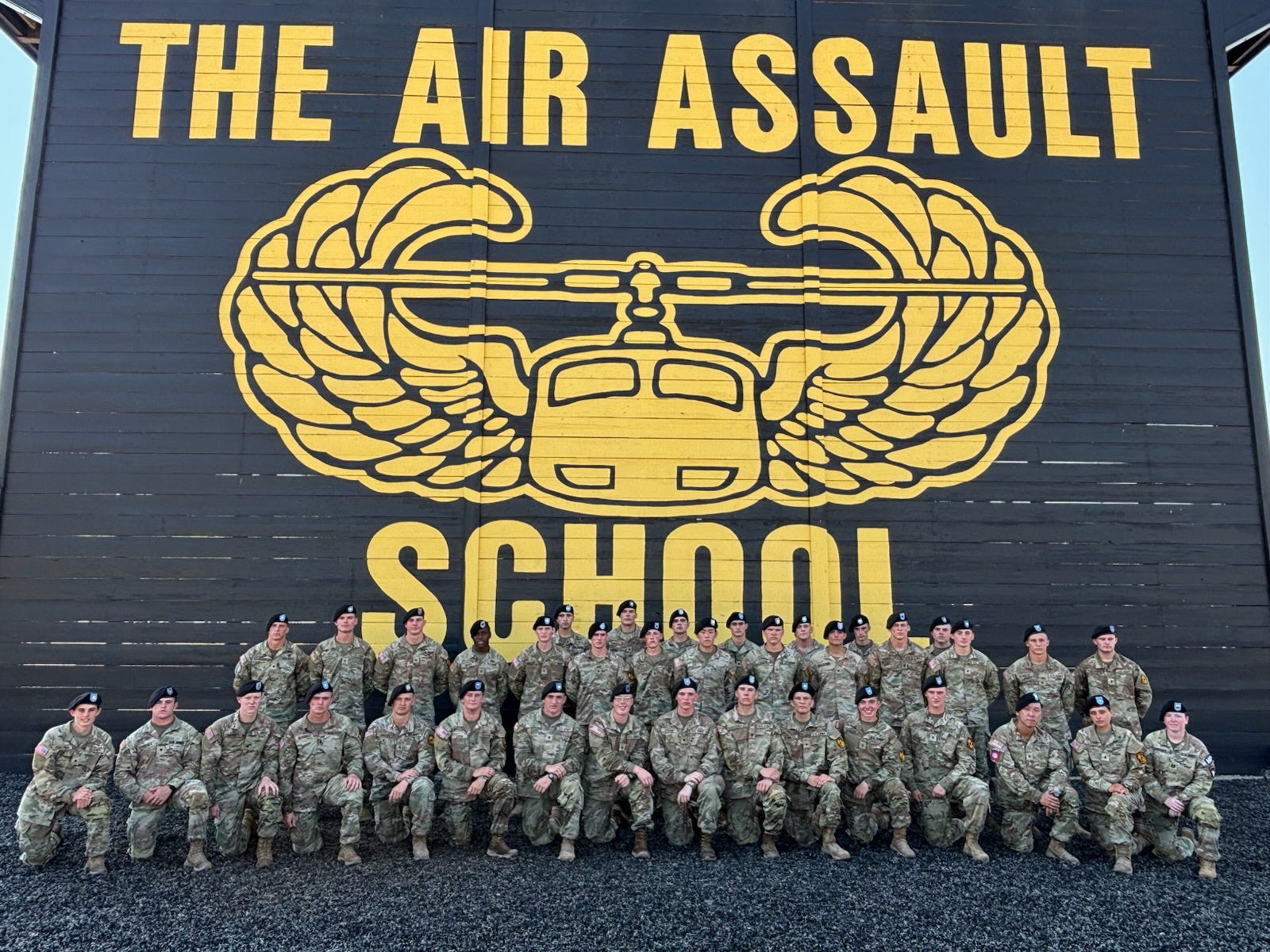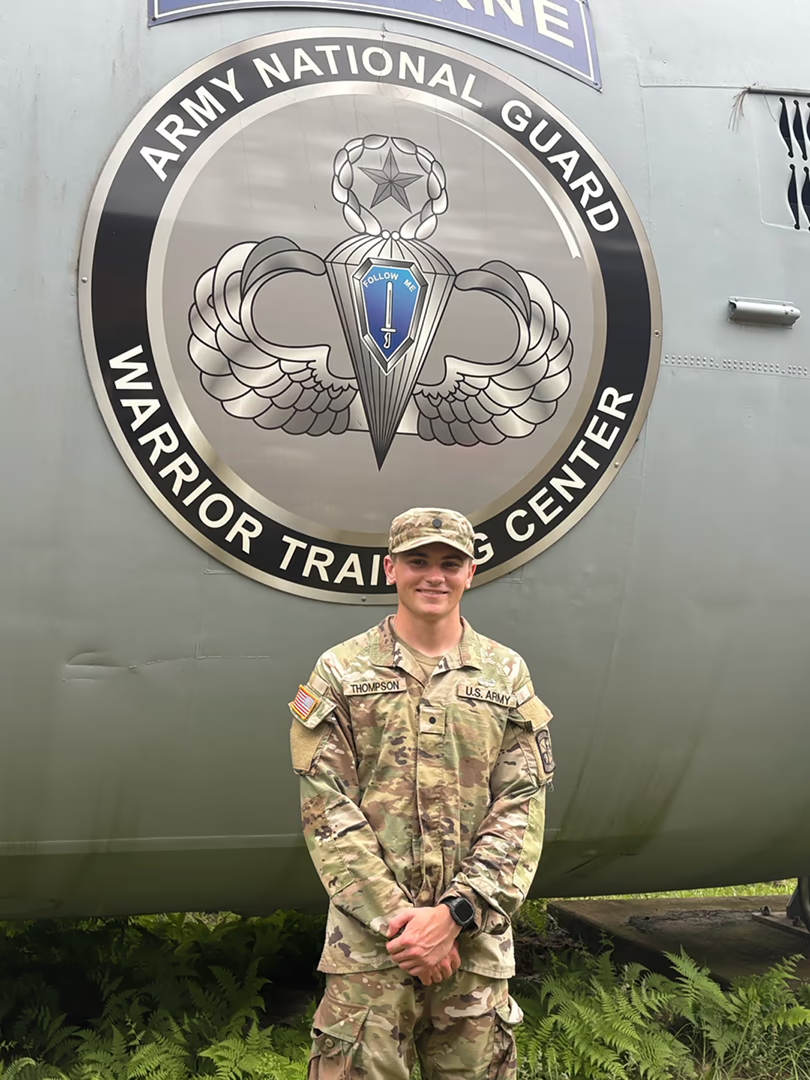Cadet Advanced Individual Training (CAIT) Schools
Once Cadets have successfully contracted with Army ROTC, they are afforded opportunities to attend highly challenging and competitive training schools. They will experience true grit at some of the most elite and advanced training courses available to the United States Army. Some will earn badges, others will don tabs – all will steel their resolve and discover new strengths.
Air Assault

The United States Army Air Assault School is a rigorous 10-day course designed to train soldiers in helicopter insertion, evacuation, and pathfinder operations. Principally located at Fort Campbell, Kentucky, it is renowned for its demanding physical and mental challenges, earning the moniker "The Ten Toughest Days in the Army".
The curriculum is divided into three phases:
- Combat Assault Phase: Focuses on aircraft safety, pathfinder operations, and combat assault techniques.
- Sling Load Operations: Teaches soldiers to rig and inspect equipment for helicopter transport, handling loads ranging from 1,000 to 8,000 pounds.
- Rappelling Phase: Involves rappelling from both a 34-foot tower and a UH-60 Black Hawk helicopter at heights of 70–90 feet.
Each phase concludes with written and practical evaluations.
Upon successful completion, soldiers are awarded the Air Assault Badge and the 2B Additional Skill Identifier (ASI), signifying their qualification in air assault operations. Graduates are also eligible for advanced courses such as Rappel Master and Fast Rope Insertion Extraction System (FRIES)/Special Purpose Insertion Extraction (SPIES) Master.
Airborne
 The United States Army Airborne School, located at Fort Benning, Georgia, is a rigorous three-week training program designed to qualify soldiers in parachute operations. The course is divided into three phases: Ground Week, Tower Week, and Jump Week. Airborne School is a testament to a soldier's physical endurance, mental resilience, and commitment to excellence in parachute operations.
The United States Army Airborne School, located at Fort Benning, Georgia, is a rigorous three-week training program designed to qualify soldiers in parachute operations. The course is divided into three phases: Ground Week, Tower Week, and Jump Week. Airborne School is a testament to a soldier's physical endurance, mental resilience, and commitment to excellence in parachute operations.
Ground Week
The first week focuses on foundational skills, including:
- Parachute Landing Falls (PLFs): Training to minimize injury upon landing.
- Mock Door Training: Simulating aircraft exits.
- Lateral Drift Apparatus: Practicing controlled landings.
Trainees must pass the Army Physical Fitness Test (APFT) to advance. This week is known for its high attrition rate due to the physical and mental challenges.
Tower Week
The second week builds on individual skills with:
- 34-Foot Tower: Practicing exits and PLFs.
- Swing Landing Trainer (SLT): Enhancing landing techniques.
- 250-Foot Freefall Tower: Simulating real jump conditions.
Trainees must qualify on these apparatuses and demonstrate proficiency in mass exit procedures to proceed.
Jump Week
The final week involves:
- Five Jumps: Including one night jump and one combat equipment jump.
- Aircraft: Exits from C-130 or C-17 aircraft at 1,250 feet.
Successful completion results in earning the Parachutist Badge and an additional skill identifier.
Mountain Warfare School
 The Army Mountain Warfare School (AMWS), located at the Camp Ethan Allen Training Site in Jericho, Vermont, is a specialized institution dedicated to training U.S. Army personnel in mountain warfare. Established in 1983, the school offers rigorous courses designed to prepare soldiers for operations in rugged, high-altitude, and cold-weather environments. The AMWS is situated in Vermont's Green Mountains, providing a challenging environment for training. The courses are physically and mentally demanding, with soldiers often engaging in 14-hour training days. For instance, during a 14-day course, soldiers navigate difficult terrain, perform rappelling, and execute casualty evacuations - all while enduring extreme weather conditions.
The Army Mountain Warfare School (AMWS), located at the Camp Ethan Allen Training Site in Jericho, Vermont, is a specialized institution dedicated to training U.S. Army personnel in mountain warfare. Established in 1983, the school offers rigorous courses designed to prepare soldiers for operations in rugged, high-altitude, and cold-weather environments. The AMWS is situated in Vermont's Green Mountains, providing a challenging environment for training. The courses are physically and mentally demanding, with soldiers often engaging in 14-hour training days. For instance, during a 14-day course, soldiers navigate difficult terrain, perform rappelling, and execute casualty evacuations - all while enduring extreme weather conditions.
The primary mission of the AMWS is to train service members in mountain warfare skills, tactics, and doctrine to enhance mobility and effectiveness in all terrain and climatic conditions. The school aims to teach soldiers how to utilize adverse terrain and weather conditions to their advantage, thereby preserving unit strength and combat power to achieve mission success. Graduates of the Basic Military Mountaineer Course (BMMC) earn the Military Mountaineer Badge, commonly known as the Ram’s Head Device, (a representation of a dall ram head) and a skill Qualification Identifier (SQI) "E," signifying their proficiency in military mountaineering.
Jungle Operations Training Course (JOTC)
The Jungle Operations Training Course (JOTC) is a 12-day program conducted at Schoffield Barracks in Hawaii aimed at preparing U.S. Army personnel for operations in dense, humid jungle environments. Established in 2013 by the 25th Infantry Division, JOTC builds upon the Army's historical expertise in jungle warfare dating back to World War II. JOTC is the U.S. Army's premier jungle warfare training program, offering soldiers the skills and experience necessary to operate effectively in challenging jungle environments.
Course Structure
Week 1: builds the individual Student’s basic skills required to be effective in a Jungle environment. Subjects covered include: Dismounted Mobility, Land Navigation, Water Crossing and Occupation, Combat Tracking, Tropical Medical Considerations, Squad Jungle Contact Drills, and Survival training. Students will be assessed individually on critical skills: Combat Water Survival Assessment (CWSA), Jungle 5K run within 40 minutes, pass the Land Navigation Assessment under time, five critical knots and two non-critical knots, and two rope systems (One Rope Bridge and 3:1 Line Haul System). Students will also demonstrate their abilities during practical exercises.
Week 2: of JOTC focuses on execution and employment of skills learned during Week One through a three-day culminating exercise (CULEX). Week Two concludes with the “Green Mile” physical endurance course, followed by recovery and graduation
Upon successful completion, soldiers earn the Jungle Tab, a distinction that enhances their professional development and is recognized during promotion evaluations.
Combat Diver Qualification Course
The Combat Diver Qualification Course (CDQC) is an intensive training program designed to qualify U.S. military personnel in combat diving operations. It is primarily conducted by the U.S. Navy’s Special Warfare Combatant-craft Crewmen (SWCC) and Navy SEAL training commands. The course is known for being highly challenging, requiring excellent physical conditioning, mental resilience, and mastery of specialized diving skills essential for maritime special operations.
Students in underwater navigation, scuba diving, combat swimming, and infiltration/exfiltration techniques for special operations missions, typically lasting 6 to 8 weeks. Training consists of:
- Open and closed-circuit diving techniques (including use of rebreathers to avoid detection).
- Underwater navigation using compass and natural landmarks.
- Combat swimming skills for covert approach.
- Boat handling and small craft operations.
- Physical conditioning with emphasis on endurance and mental toughness.
- Emergency procedures such as underwater escape and rescue.
Graduates earn the Combat Diver qualification badge and are qualified to conduct clandestine underwater missions, supporting special warfare and reconnaissance operations.
Cadet Troop Leading Training (CTLT)

Cadet Troop Leading Training (CTLT) is a key component of the U.S. Army ROTC Cadet Professional Development Training program. It provides cadets—typically between their junior and senior years of college—the opportunity to gain hands-on leadership experience in real Army units. CTLT immerses cadets in the daily life and duties of a Second Lieutenant by assigning them to serve in active-duty Army units for 3 to 4 weeks. This real-world exposure helps cadets understand the responsibilities and expectations of commissioned officers.
Key Features
- Assignment to Active Units: Cadets are placed in units across the U.S. (CONUS) or overseas (OCONUS), including in Europe, Korea, and other locations.
- Platoon Leadership Roles: Cadets typically shadow and assist platoon leaders, gaining experience in planning, operations, soldier management, and unit leadership.
- Mentorship: Cadets receive guidance from experienced officers and NCOs, helping them refine leadership and decision-making skills.
- Evaluation: Each cadet receives an Officer Evaluation Report (OER), which can contribute to their overall ROTC performance assessment.